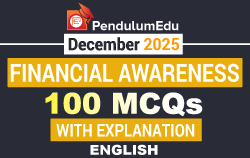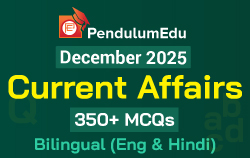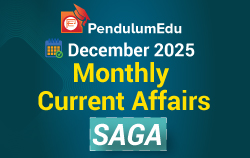Newspaper during Indian Freedom Struggle
1. Development of Indian Press
Indian press history started with the arrival of Europeans.
The Portuguese were the first Europeans to bring a printing press to India, and the Jesuits of Goa published the first book in India in 1557.
James Augustus Hickey was a pioneer in the field of newspaper publishing in India.
In 1780, he established "The Bengal Gazette or Calcutta General Advertiser," which was the first newspaper in India.
However, in 1782, Hickey's press was seized because to his outspoken criticism of the Government.
2. Regulations on Indian Newspapers before Independence
2.1. Censorship of Press Act, 1799:
Lord Wellesley established Press Censorship in 1799, which imposed strict restrictions on newspapers published in India.
2.2. The Licensing Regulation, 1823:
These were enacted by the acting governor-general, John Adams, who had reactionary views.
The publication of Raja Ram Mohan Roy's journal, "Mirat-Ul-Akbar," had to be stopped because of these restrictions.
2.3. Press Act of 1835 or Metcalfe Act:
The Press Act, often known as the Metcalfe Act, repealed the 1823 Licensing Regulations.
Governor General Charles Metcalfe was recognised in India as the "liberator of the press."
2.4. Licensing Act, 1857:
Governor General Lord Canning (later Viceroy in 1858) enacted the Licensing Act, due to the emergency arising out of the Revolt of 1857.
2.5. Registration Act, 1867:
The Metcalf Act of 1835 was replaced by the Registration Act of 1867.
2.6. Vernacular Press Act, 1878:
Viceroy Lytton enacted the Vernacular Press Act to restrict the freedom of Indian language newspapers.
The Act was repealed by Ripon in 1882 after strong opposition.
Surendranath Banerjee was the first Indian journalist imprisoned in 1883.
2.7. Newspaper (Incitement to Offences) Act, 1908:
Under the act, a magistrate could seize press property if it included unacceptable material likely to encourage murder or violence.
2.8. Indian Press Act, 1910:
This act revived the Vernacular Press Act's worst provisions.
2.9. Indian Press (Emergency Powers) Act, 1931:
The Indian Press (Emergency Powers) Act was enacted following the Civil Disobedience movement.
2.10. During The Second World War:
Repression was enforced under the Defence of India Rules, and the Press Emergency Act and the Official Secrets Act were amended.
3. Early Nationalists' Struggle for Press Freedom
Defense of civil freedoms, including press freedom, had been a priority for the nationalist agenda since the early nineteenth century.
Raja Rammohan Roy had protested against a resolution restricting press freedom as early as 1824.
The government had enacted a number of punishing legislation, including Section 124 A of the Indian Penal Code.
After World War I, the Press Acts of 1908 and 1910 were repealed in 1921 after the recommendations of a Press Committee chaired by Tej Bahadur Sapru.
4. Regulations on Indian Newspapers after Independence
4.1. Press Enquiry Committee, 1947:
In view of the fundamental rights formulated by the Constituent Assembly, the Committee was formed to examine press laws.
4.2. Press (Objectionable Matters) Act, 1951:
Along with the amendment in the Article 19 (2) of the Constitution, the Act was passed.
4.3. Press Commission under Justice Rajadhyaksha:
In 1954, the commission made some recommendations:
-
The establishment of All India Press Council
-
Fixing the press-page schedule system for newspapers, etc.
5. Important Indian Newspapers during Indian Freedom Struggle
Newspapers and Magazines played an important role in Indian Freedom struggle by spreading awareness among the masses to join the freedom struggle movement against the British and attain Independence.
List of Indian Newspapers and Magazines during Freedom Struggle:
| Name of the paper/ Journal | Founder / Editor | Year | Publication place |
| Bengal Gazette (Also Calcutta General Advertiser) | James Augustus Hicky | 1780 |
Calcutta
|
| Madras Courier (First paper from Madras) | ------ | 1784 | Madras |
| India Gazette | Henry Louis Vivian Derozio associated with it. | 1787 | Calcutta |
| Bombay Herald (First paper from Bombay) | ------ | 1789 | Bombay |
| Indian Herald (in English) | Started by R. Williams (English-man) Published by Humphreys | 1795 |
Madras
|
| Digdarshana (First Bengali monthly) | ----- | 1818 | Calcutta |
| Calcutta Journal | Started by J.S. Buckingham | 1818 | ----- |
| Bengal Gazette (First Bengali newspaper) | Harishchandra Ray | 1818 | Calcutta |
| Sambad Kaumudi (Weekly in Bengali) | Raja Rammohan Roy | 1821 | ---- |
| Mirat-ul-Akbar (First journal in Persian) | Raja Ram Mohan Roy | 1822 | Calcutta |
| Jam-i-Jahan Numah (First paper in Urdu) | An English firm | 1822 | Calcutta |
| Banga-Duta (a weekly in four languages—English, Bengali, Persian, Hindi) | Rammohan Roy, Dwarkanath Tagore and others | 1822 | Calcutta |
| Bombay Samachar (First paper in Gujarati) | ----- | 1822 | Bombay |
| East Indian (daily) | Henry Vivian Derozio | 19th century | ----- |
| Bombay Times (From 1861 onwards, The Times of India) | Foundation laid by Robert Knight Started by Thomas Bennett. | 1838 | Bombay |
| Rast Goftar (A Gujarati fortnightly) | Dadabhai Naoroji | 1851 | ----- |
| Hindoo Patriot | Girishchandra Ghosh (later, Harishchandra Mukerji became owner-cum-editor) | 1853 | Calcutta |
| Somaprakasha (First Bengali political paper) | Dwarkanath Vidyabhushan | 1858 | Calcutta |
| Indian Mirror (Fortnightly— Early 1862, Calcutta first Indian daily paper in English) | Devendra Nath Tagore | 1862 | Calcutta |
| Bengalee (this, and Amrita Bazar Patrika—the first vernacular papers) | Girishchandra Ghosh (taken over by S.N. Banerjea in 1879) | 1862 | Calcutta |
| National Paper | Devendranath Tagore | 1865 | Calcutta |
| Madras Mail (First evening paper in India) | ----- | 1868 | Madras |
| Amrita Bazar Patrika (Bengali in the beginning, later English, a daily) | Shishir Kumar Ghosh and Motilal Ghosh | 1868 | Jessore District (Bangladesh) |
| Indian Statesman (later, The Statesman) | Started by Robert Knight | 1875 | Calcutta |
| The Hindu (in English)— started as weekly | G.S. Aiyar, Viraraghavachari and Subba Rao Pandit (Among the founders) | 1878 | Madras |
| Tribune (daily) | Dayal Singh Majeetia | 1881 | Lahore |
| Kesari (Marathi daily) and Maharatta (English weekly) | Tilak, Chiplunkar, Agarkar (before Tilak, Agarkar and Prof Kelkar were the editors respectively) | 1881 | Bombay |
| Swadeshamitram (a Tamil paper) | G. S. Aiyar | 1882 | Madras |
| Sanjibani (Bengali journal) | Krishna Kumar Mitra | 1883 | ---- |
| Voice of India | Dadabhai Naoroji | 1883 | Bombay |
| Paridasak (a weekly) | Bipin Chandra Pal (publisher) | 1886 | ---- |
| Deepika | Nidhiry Mani Kathanar | 1887 | Mannanam, near Kottayam |
| Sudharak | Gopal Ganesh Agarkar | 1888 | Pune |
| Prabuddha Bharata | P. Aiyasami, B. R. Rajam Iyer, G. G. Narasimhacharya, and B. V. Kamesvara Iyer at the behest of Swami Vivekananda | 1896 | Madras |
| Udbodhana (Magazine) | Swami Vivekananda | 1899 | ----- |
| Indian Opinion | M. K Gandhi | 1903 | Durban (South Africa) |
| Free Hindustan | Taraknath Das | 1905 | Vancouver |
| Talvar | Birendra Nath Chattopadhyay | ---- | Berlin |
| Ghadr | Ghadr Party | ---- | San Francisco |
| Bande Mataram | Aurobindo Ghosh, Bipin Chandra Pal | 1905 | Calcutta |
| Yugantar | Barindar Kumar Ghosh, Bhupendra Dutta | 1906 | Bengal |
| Sandhya | B. B. Upadhya | 1906 | Bengal |
| Kal | ----- | 1906 | Maharashtra |
| Reshwa | Ajit Singh | Before 1908 | ---- |
| Indian Sociologist | Shyamji Krishnavarma |
| London |
| Comrade | Maulana Mohammad Ali | 1911 | ----- |
| Al-Balagh | Abul Kalam Azad | 1912 | ----- |
| Al-Hilal | Abul Kalam Azad | 1912 | ----- |
| Bombay Chronicle | Started by Pherozesha Mehta, Editor—B.G. Horniman (Englishman) | 1913 | Bombay |
| Pratap | Ganesh Shankar Vidyarthi | 1913 | ----- |
| New India | Annie Besant | 1914 | ----- |
| Commonweal | Annie Besant | 1914 | ---- |
| Independent | Motilal Nehru | 1919 | Allahabad |
| Young India | M. K Gandhi | 1919 | ---- |
| Tarun Bharat | Baburao Thaku | 1919 | Belgaum |
| Mook Nayak | B.R. Ambedkar | 1920 | ----- |
| The Hindustan Times | Founded by K.M. Panikkar as part of the Akali Dal Movement | 1920 | Delhi |
| Indian Socialist | S. A. Dange | 1922 | ---- |
| Vanguard | M. N. Roy | 1922 | ---- |
| Anandabazar Patrika | Suresh Majumdar Parfulla Sarkar | 1922 | ---- |
| Bandi Jivan | Sachindranath Sanyal | 1922 | Bengal |
| The Milap (Urdu daily) | Founded by M.K. Chand | 1923 | Lahore |
| Leader (in English) | Madan Mohan Malaviya | ---- | ---- |
| Nava Kaal | Prabhakar Khadilkar | 1923 | ---- |
| Mathrubhumi (Malayalam newspaper) | K. P. Kesava Menon | 1923 | ---- |
| Kudi Arasu (Tamil weekly magazine) | E. V. Ramaswamy Naickar (Periyar) | 1925 | Madras |
| Kirti | Santosh Singh | 1926 | Punjab |
| Future of Indian Politics (Communist journal) | M. N. Roy | 1926 | ---- |
| Bahishkrit Bharat (Marathi fortnightly) | B.R. Ambedkar | 1927 | ---- |
| Langal and Ganabani | Goswami | 1927 | Bengal |
| Kranti | S. S. Mirajkar,K. N. Joglekar,S. V. Ghate | 1927 | Maharashtra |
| Navi Jeevan | M. K Gandhi | 1929 | ---- |
| Harijan Sevak (Hindi newspaper) | M. K Gandhi | 1932 | ---- |
| Harijan Bandu (Gujarati newspaper) | M. K Gandhi | 1932 | ----- |
| Bandi Jivan | Sachindranath Sanyal | ---- | Bengal |
| Free Hindustan (Journal) | Tarak Nath Das | 1936 | ------ |
| Hindustan Dainik | M.M. Malviya | 1936 | ---- |
| National Herald (daily) | Started by Jawaharlal Nehru | 1938 | ---- |
| Dawn (English newspaper, Mouthpiece for Muslim League) | Mohammad Ali Jinnah | 1941 | Delhi |




 Latest
Latest 



Comments